Shellfish
The term shellfish refers to edible aquative invertebrates that have exoskeletons, or shells. Species in Puget Sound range from Dungeness crabs and oysters to shrimp and squid.
RELATED ARTICLES
Implementation Strategy for Puget Sound’s Shellfish Beds Recovery Target
This article provides an overview and a link to further information about the Shellfish Implementation Strategy. Implementation Strategies (Strategies) are plans for accelerating progress toward the 2020 ecosystem recovery targets for the Puget Sound Vital Signs. The Strategies are developed collaboratively with technical, professional, and policy experts and with local and regional input. They are funded by the Environmental Protection Agency.
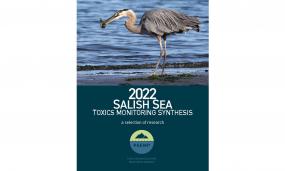
2022 Salish Sea toxics monitoring synthesis: A selection of research
A 2023 report from the Puget Sound Ecosystem Monitoring Program presents an overview of selected recent monitoring and research activities focused on toxic contaminants in the Salish Sea.
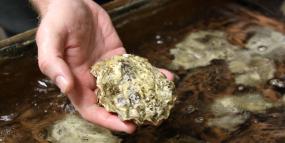
Researchers use a qualitative network model to test ways to boost production at shellfish farms
The skeletal beginnings of nearly all models is a conceptual understanding of the basic workings of the system being studied: Who are the important actors, and what are their roles within the system?
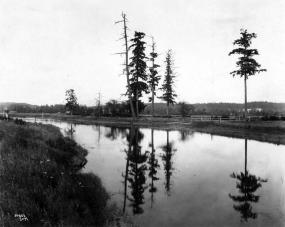
Legal milestones for Indigenous sovereignty and salmon co-management in the Puget Sound region
Treaty rights are critical to the sovereignity of Puget Sound area Tribes and are deeply connected to natural resource management. Five landmark treaties in our region were signed during a three-year period from 1854 to 1856 and continue to drive policy to this day.
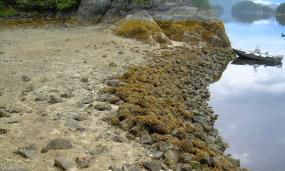
First modern clam garden takes shape in Puget Sound
The Swinomish Indian Tribal Community has begun constructing the first known clam garden to be built in modern times. They hope that what was once an ancient way of cultivating shellfish can now be a hedge against climate change.
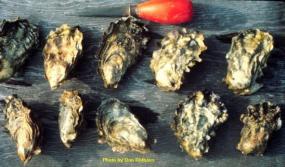
Regional perspectives on the effectiveness of Puget Sound shellfish recovery actions
A 2021 report commissioned by the Washington State Department of Natural Resources identifies potential actions at the state or local level, or in combination, that could further bolster shellfish bed recovery in support of the Puget Sound Partnership's shellfish bed recovery target.

Eyes Over Puget Sound: Surface Conditions Report - April 1, 2021
After a wet winter/spring transition it has been noticeably drier, warmer and sunnier. River flows are near normal levels and in Puget Sound and coastal bays salinity is increasing above normal. The spring bloom is developing but not very pronounced, yet, Noctiluca is already visible in southern Hood Canal. Suspended sediment near rivers and creeks, failing bluffs, and shellfish activities are frequent. Capturing herring spawning from the plane is informative; pilots share their observations.

Delicious and now endangered: Can the pinto abalone make a comeback?
The pinto abalone was a popular sport catch for divers in the Salish Sea until its numbers plummeted to near extinction. Now, the delicious marine snail is on the endangered species list and the focus of an ambitious hatchery and replanting program. A broad coalition of partners has released more than 20,000 young pintos into the wild with the hope that the population will start to rebound.

Pathogens Prevention Reduction and Control 5-6 (PC-00J88801) Final Report
The Pathogens Prevention Reduction and Control agreement between the Environmental Protection Agency and the Washington State Department of Health focuses on the prevention and reduction of pathogen pollution in Puget Sound through the management of human and animal waste. The primary objectives of the agreement include restoring shellfish growing areas, avoiding shellfish closures, and protecting people from disease.
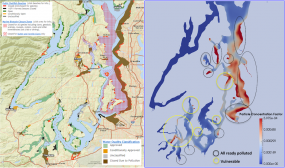
Ecosystem models expand our understanding of the Salish Sea
Scientists are using computer models to address complex issues in the Salish Sea like the rise of harmful algal blooms and the movement of toxic PCBs. LiveOcean, Atlantis and the Salish Sea Model are three systems that are changing the game for ecologists and other researchers.
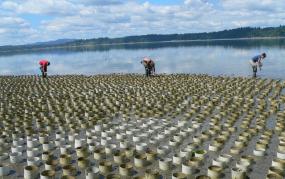
A history of Puget Sound's 'boss clam'
The geoduck has earned an honored place as Puget Sound's largest and most distinctive native clam, but how much do we really know about it? Often seen as a culinary curiosity, the geoduck has only been commercially harvested on a large scale since the 1970s, and the clam's current popularity is based mostly on demand from Asian markets. Nevertheless, this deep-burrowing mollusk has always been a signature part of the Salish Sea ecosystem.
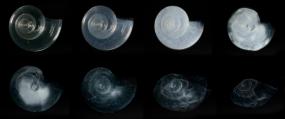
Rate of ocean acidification may accelerate, scientists warn
Last summer, scientists met at the University of Washington to address alarming findings concerning the rapid acidification of the world's oceans. Experts at that symposium warned that wildlife in the Salish Sea, from salmon to shellfish, may start to see significant effects from changing water chemistry within the next 10 to 20 years. This article summarizes the symposium's key findings and was commissioned and edited by the Washington Ocean Acidification Center which hosted the gathering. Funds for the article were provided by the Washington state legislature. [A version of this article was originally published by the Washington Ocean Acidification Center.]
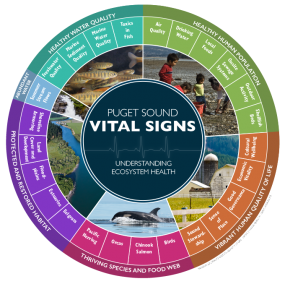
Toxics in Fish Implementation Strategy
The Toxics in Fish Implementation Strategy is a recovery plan that will guide funding and activities to reduce the impacts of toxics contaminants on marine fish and the humans that consume them. A final version of the plan was published in May 2021.
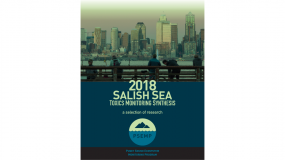
2018 Salish Sea toxics monitoring synthesis: A selection of research
A 2019 report from the Puget Sound Ecosystem Monitoring Program presents an overview of selected recent monitoring and research activities focused on toxic contaminants in the Salish Sea.
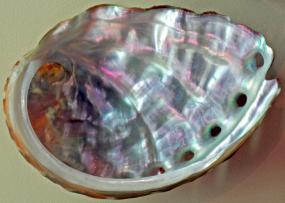
The survival of hatchery‐origin pinto abalone Haliotis kamtschatkana released into Washington waters
In Washington State, the pinto abalone (Haliotis kamtschatkana) has declined by 97 percent since 1992 and is unlikely to recover without intervention. A captive rearing and restocking pilot study shows promise for saving wild populations from local extinction.
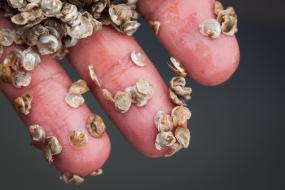
Return of a native: Olympia oysters are making a comeback
Puget Sound’s only native oysters were nearly wiped out in the 19th century from overharvesting. Now a network of scientists and advocates is working to restore them to their historical and cultural prominence.
Pathogens prevention reduction and control 1-4 (PC-00J32601): Final report
A report from the Washington State Department of Health outlines results from a series of projects funded by the U.S. Environmental Protection Agency's National Estuary Program in 2011. These projects addressed pathogen pollution in Puget Sound through the management of human and animal waste. Restoring shellfish growing areas, avoiding shellfish closures, and protecting people from disease served as the primary objectives.
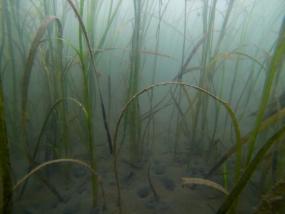
Ocean acidification may be twice as extreme in Puget Sound’s seagrass habitats, threatening Dungeness crabs
Ocean acidification could be up to twice as severe in fragile seagrass habitats as it is in the open ocean, according to a study published last April in the Proceedings of the National Academy of Sciences. The conditions may threaten Dungeness crabs by 2050 and will be especially pronounced in the winter, the study says.
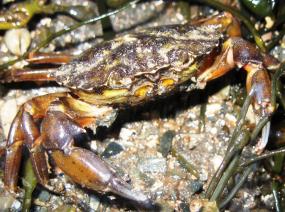
Where did the Puget Sound green crabs come from? We’re still not sure
Genetic testing shows that invasive European green crabs in Puget Sound likely did not come from the Sooke Basin in British Columbia as previously thought. New findings on the crab's origins were presented at the 2018 Salish Sea Ecosystem Conference in Seattle.
![Bay Mussels (Mytilus trossulus) on Edmonds Ferry Dock. Photo [cropped]: brewbooks (CC BY-SA 2.0) https://www.flickr.com/photos/brewbooks/8840874065 Bay Mussels (Mytilus trossulus) on Edmonds Ferry Dock. Photo [cropped]: brewbooks (CC BY-SA 2.0) https://www.flickr.com/photos/brewbooks/8840874065](https://www.eopugetsound.org/sites/default/files/styles/scale_width_285/public/topical_article/images/8840874065_da3b29ce56_crop_1200_0.jpg?itok=f8GftDPu)
Bay mussels in Puget Sound show traces of oxycodone
State agencies tracking pollution levels in Puget Sound have discovered traces of oxycodone in the tissues of native bay mussels (Mytilus trossulus) from Seattle and Bremerton area harbors. The findings were presented at the 2018 Salish Sea Ecosystem Conference in Seattle.
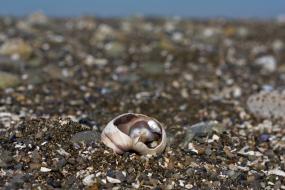
Using mineralogy and higher-level taxonomy as indicators of species sensitivity to pH: A case-study of Puget Sound
Scientists from NOAA's Northwest Fisheries Science Center (NWFSC) developed publicly searchable database of nearly 3,000 Puget Sound species to study whether species having calcium carbonate shells are more or less vulnerable to ocean acidification. Their findings published in the journal Elementa question previous assumptions that shell-building organisms are more vulnerable.
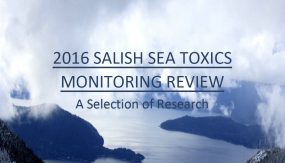
2016 Salish Sea toxics monitoring review: A selection of research
A 2017 report from the Puget Sound Ecosystem Monitoring Program presents an overview of selected recent monitoring and research activities focused on toxic contaminants in the Salish Sea.

Puget Sound Ecosystem Monitoring Program
The Puget Sound Ecosystem Monitoring Program (PSEMP) is an independent program established by state and federal statute to monitor environmental conditions in Puget Sound.

Bringing the shellfish back: How Drayton Harbor overcame a legacy of pollution
After a long struggle with pollution, Drayton Harbor has reopened to year-round commercial oyster harvesting for the first time in 22 years. Here’s how the community cleaned up its act, potentially showing the way for shellfish recovery throughout Puget Sound.
![Bay Mussels (Mytilus trossulus) on Edmonds Ferry Dock. Photo [cropped]: brewbooks (CC BY-SA 2.0) https://www.flickr.com/photos/brewbooks/8840874065 Bay Mussels (Mytilus trossulus) on Edmonds Ferry Dock. Photo [cropped]: brewbooks (CC BY-SA 2.0) https://www.flickr.com/photos/brewbooks/8840874065](https://www.eopugetsound.org/sites/default/files/styles/scale_width_285/public/topical_article/images/8840874065_da3b29ce56_crop_1200.jpg?itok=OfqCr_7G)
Salish Sea snapshots: Mussel memory
Scientists are testing ways to use transplanted shellfish such as mussels to monitor toxic contaminants in Puget Sound.
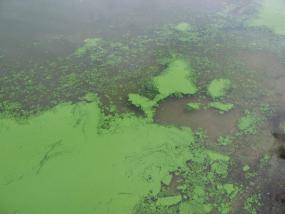
Salish Sea snapshots: Invasive species and human health
Invasive species are considered a top threat to the balance of ecosystems worldwide. New discoveries of non-native green crabs in Puget Sound have highlighted that concern here at home, but invasive species can impact more than just the food web. Some introduced species can produce toxins that accumulate in shellfish or by directly infecting the human body.
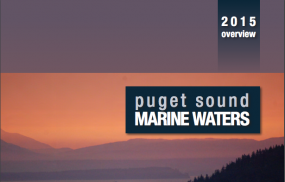
2015 Puget Sound Marine Waters Overview
The Puget Sound Ecosystem Monitoring Program released its fifth annual Marine Waters Overview this week. The report provides an assessment of marine conditions for the year 2015 and includes updates on water quality as well as status reports for select plankton, seabirds, fish and marine mammals.
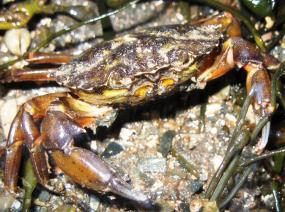
Second invasive green crab found in Puget Sound
Another European green crab has been spotted in Puget Sound prompting concern that the species may gain a foothold in the region.
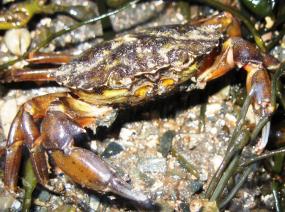
Green crabs could impair Puget Sound shellfish operations
Concerns over the potential arrival of the European green crab have inspired a small army of volunteers. A search is underway for early signs of an invasion.
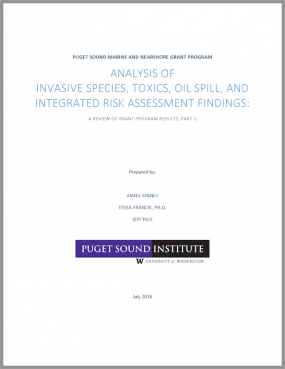
A review of Puget Sound marine and nearshore grant program results, Part 2
A July 2016 report from the University of Washington Puget Sound Institute summarizes and reviews 10 EPA-funded projects focusing on Puget Sound's marine and nearshore environments. The projects were conducted between 2011-2015 with support from the EPA's National Estuary Program. The report is an analysis of findings on invasive species, toxics, oil spill, and integrated risk assessment.
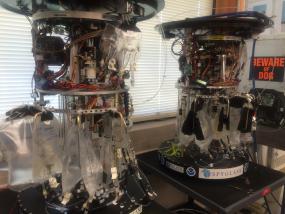
Salish Sea snapshots: Detecting harmful algal blooms
Environmental samplers may provide early detection of harmful algal blooms (HABs) in Puget Sound. This toxic algae is expected to increase as the climate changes, bringing with it new and potentially more severe outbreaks of shellfish poisonings.

Harmful algal blooms in Puget Sound
An algal bloom is a rapid increase or accumulation in the population of algae in a water system. While most are innocuous, there are a small number of algae species that produce harmful toxins to humans and animals.
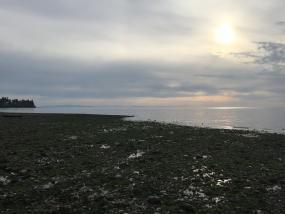
Birch Bay characterization and watershed planning pilot – taking action
A 2015 report from the Whatcom Conservation District and Whatcom County describes a pilot watershed characterization study focusing on the Terrell Creek and Birch Bay areas. The report and related appendices are available for download.
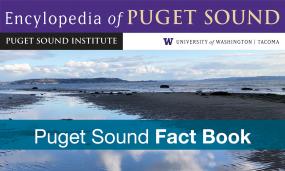
Puget Sound Fact Book
The Puget Sound Fact Book brings together statistics and other information about the health and makeup of the Puget Sound ecosystem. Areas of focus include climate change, geography, water quality, habitats, human dimensions and regional species. The fact book was prepared for the Encyclopedia of Puget Sound with funding from the Environmental Protection Agency and the Puget Sound Partnership.
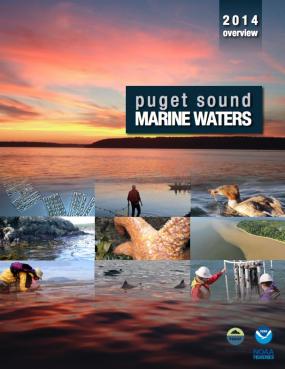
2014 Puget Sound Marine Waters Overview
A report from NOAA and the Puget Sound Ecosystem Monitoring Program provides an overview of 2014 marine water quality and conditions in Puget Sound from comprehensive monitoring and observing programs.

Puget Sound Water Quality Conference Proceedings
The Puget Sound Water Quality Conference was held in Seattle, Washington, on September 30 and October 1, 1983. It included prominent speakers from the Puget Sound region, other parts of the United States, and Canada.
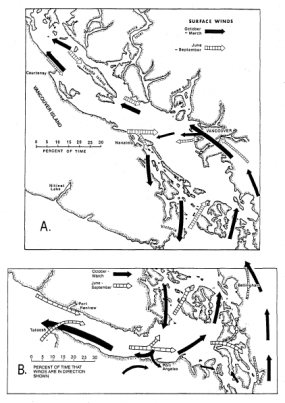
Review of the marine environment and biota of Strait of Georgia, Puget Sound and Juan de Fuca Strait
Proceedings of the BC/Washington Symposium on the Marine Environment, January 13 and 14, 1994
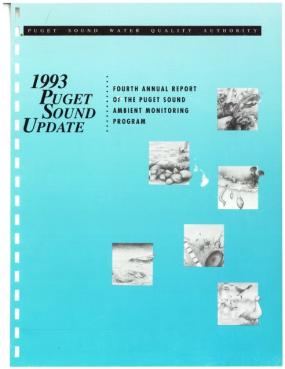
1993 Puget Sound Update
The 1993 Puget Sound Update—the fourth annual report of this program—evaluates the data collected by PSAMP in 1992 (the most recent year for which the data have undergone quality assurance review and interpretation) and compares these data to past information on Puget Sound water quality.
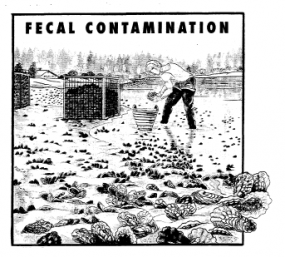
1994 Puget Sound Update
The 1994 Puget Sound Update—the fifth annual summary report of this program—evaluates the data collected by the PSAMP in 1993 (the most recent year for which the data have undergone quality assurance review and interpretation) and compares these data to past information on Puget Sound.
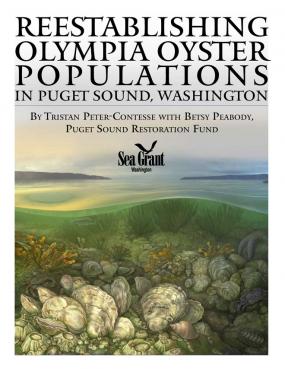
Reestablishing Olympia oyster populations in Puget Sound, Washington
A 2005 report from the Washington Sea Grant Program describing the history and current state of native Olympia oysters including their ecology, history with human interactions, prefered habitat, and reestablishment efforts in the Puget Sound region.
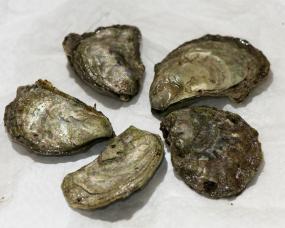
Gifts from the sea: shellfish as an ecosystem service
The region's famed mollusks provide more than just money and jobs. They offer what are called ecosystem services—a wide variety of benefits that humans derive from an ecosystem.
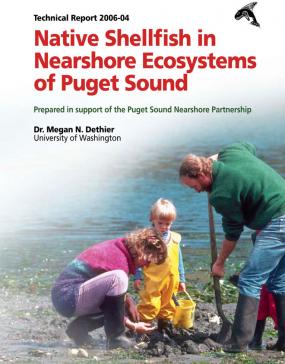
Native shellfish in nearshore ecosystems of Puget Sound
This 2006 technical report for the Puget Sound Nearshore Partnership describes how shellfish have high ecological, economical, cultural, recreational value, however human activity is threatening their existence by altering their native habitat with changes in land use, shoreline modifications, stormwater, sewage and industrial discharge.
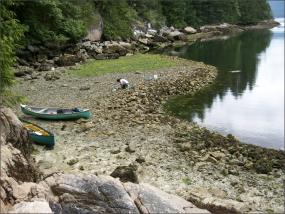
Ancient clam gardens of the Northwest Coast of North America
Northwest Coast First Peoples made clam garden terraces to expand ideal clam habitat at tidal heights that provided optimal conditions for clam growth and survival, therefore enhancing food production and increasing food security.
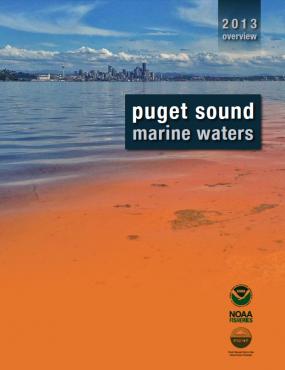
2013 Puget Sound Marine Waters Overview
A report from the Puget Sound Ecosystem Monitoring Program provides an overview of 2013 marine water quality and conditions in Puget Sound from comprehensive monitoring and observing programs.

Shedding new light on eelgrass recovery
Scientists say eelgrass, an unassuming flowering plant found just off shore in Puget Sound, is vital to the health of the ecosystem. They also say the plant is declining. New and increasingly urgent efforts to restore it brought a group of researchers to the 2014 Salish Sea Ecosystem Conference.
Regional investigations into the effects of CECs
Several research groups in the region are investigating biological markers and/or impacts of Contaminant of Emerging Concern (CEC) exposure in different organisms. An abstract describing each study is included below. Also included are links or contact details for further information about each project.
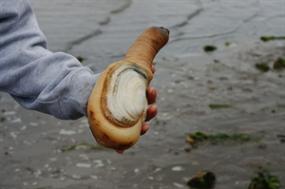
Effects of geoduck aquaculture on the environment—a synthesis of current knowledge
A November 2013 literature review by Washingtom Sea Grant synthesizes the state of the science of geoduck clams and the potential environmental impacts of geoduck aquaculture in the Puget Sound region.

2012 Puget Sound Marine Waters Overview
The Puget Sound Marine Waters 2012 Overview from the Puget Sound Ecosystem Monitoring Program synthesizes conditions measured in 2012 and has been expanded to include observations on seabirds that rely on marine waters. Read an excerpt below, or download the full report.
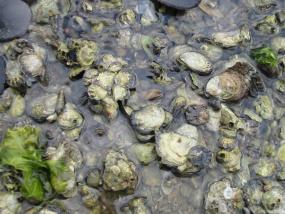
Native shellfish in nearshore ecosystems of Puget Sound
This is the executive summary from a technical report produced for the Puget Sound Nearshore Partnership on Valued Ecosystem Components (VEC). The entire document is included as a PDF with this summary.
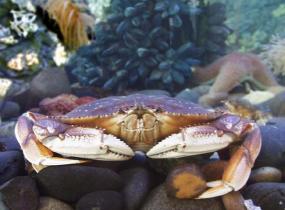
Dungeness crabs in Puget Sound
Dungeness crabs are an important resource in Puget Sound for recreational, commercial, and tribal fisheries. They utilize a variety of habitats over the course of their lives, and are vulnerable to shifts in ocean temperature and water quality.
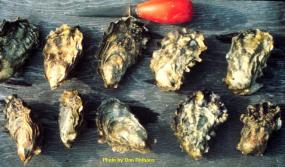
Bivalves in Puget Sound
Many types of bivalves, both native and non-native, flourish in Puget Sound. These species are a crucial part of the Puget Sound ecosystem and are also important for commercial fisheries.
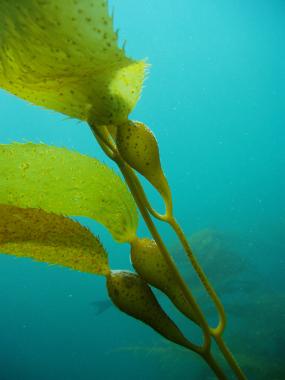
Sweetening the waters - the feasibility and efficacy of measures to protect Washington’s marine resources from ocean acidification
Washington State's ocean acidification initiative began with the launch of Governer Christine Gregoire's Blue Ribbon Panel on Ocean Acidification in December 2011. The initiative is the first of its kind in the country, and a report commissioned by the Global Ocean Health Program was released in November 2012. The report is a first step towards assessing and improving the tools at hand.
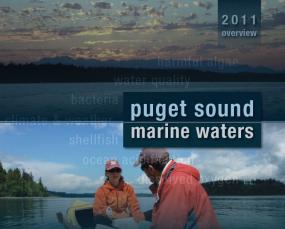
2011 Puget Sound Marine Waters Overview
The Puget Sound Marine Waters 2011 report is now available. The report was produced by the Puget Sound Ecosystem Monitoring Program and assesses the condition and quality of the waters of Puget Sound.
